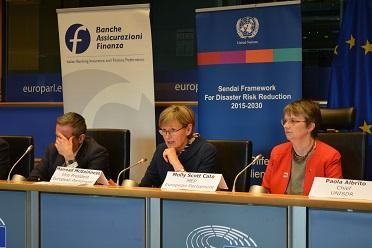
Mairead McGuinness, Vice-President of the European Parliament, speaking on resilience to disasters and sustainable finance
By Rosalind Cook
Brussels, 6 March 2018 – Disaster risk reduction is on the agenda as the EU moves towards greater integration of capital markets and a more risk-informed approach to capital investments in a world where disasters are now estimated to cost the global economy US$520 billion annually.
Speaking in a discussion last week, Mairead McGuinness, Vice President of the European Parliament, underlined that “this is really about prevention: being prepared in the future to avoid the worst impacts”.
The event organized by the UN Office of the United Nations for Disaster Risk Reduction (UNISDR) and the Italian Banking Insurance and Finance Federation, (FeBAF) was entitled “Resilience to Disasters, Capital Markets Union, and Sustainable Finance: Leveraging Partnership and Protecting Citizens, European Growth and Jobs.”
Much of the discussion focused on how Europe is vulnerable to disaster risks and concrete solutions to overcome these challenges in the context of the European Commission’s priority initiative on Capital Markets Union and how to include disaster risk in developments taking place on sustainable finance.
Paola Albrito, Chief of the Regional Office for Europe at UNISDR explained how disaster risk reduction is important for achieving economic growth and sustainable development. She highlighted both the direct and indirect costs of disasters and pointed out that in Europe losses from weather-related events have almost doubled from an average of €7.5 billion in 1980-1989 to an average of €13.3 billion in 2010-2016.
However, there is a positive momentum for change. “As Europe has increased its awareness of these societal costs, opportunities are being created for enabling a change of gear and a more effective approach to the issues,” stated Paolo Garonna, FeBAF’s Secretary General at the conference.